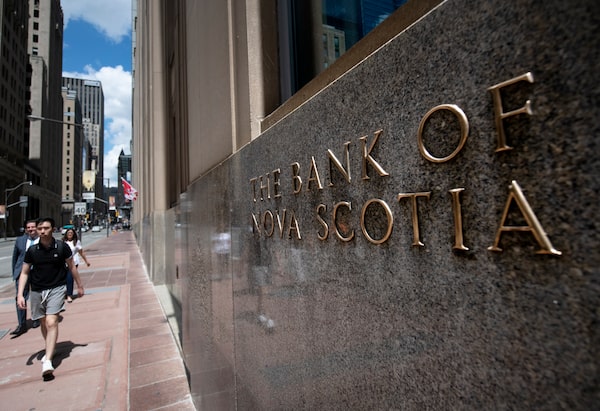
People walking past the Bank of Nova Scotia, on Bay St. in Toronto’s Financial District are photographed on July 12, 2022. Fred Lum/The Globe and Mail.Fred Lum/The Globe and Mail
Getting caught up on a week that got away? Here’s your weekly digest of The Globe’s most essential business and investing stories, with insights and analysis from the pros, stock tips, portfolio strategies and more.
Scotiabank’s succession spectacle
Scotiabank’s board of directors has appointed a new CEO to replace Brian Porter, who retires next January. But in a surprising twist, it has chosen a wild card: Scott Thomson, who currently runs Finning International, an industrial company. Sure, Mr. Thomson has served on the bank’s board since 2016, but that doesn’t explain why he was considered in the first place, writes Tim Kiladze. Over the past six months, Bay Street gossip was occupied with which Scotiabank executive would succeed Mr. Porter: Canadian banking head Dan Rees, or global markets chief Jake Lawrence? By going with Mr. Thomson instead, Scotiabank’s board has inadvertently created more chaos and uncertainty at a company that’s already been through so much upheaval over the past few years. Want more Scotiabank news? Might be a good time to take a look at their share price.
TorStar owners locked in legal battle over company’s future
The two men who own NordStar Capital Inc. and the companies it controls, which includes TorStar Corp. and newspapers like the Toronto Star and Hamilton Spectator, are in a legal battle that’s raising uncertainty about its future. As Joe Castaldo writes, co-owner Paul Rivett filed an application with the Ontario Superior Court of Justice on Sept. 1, alleging that Jordan Bitove thwarted business plans they had agreed to and attempted to sideline him. Mr. Rivett asked the court to appoint PricewaterhouseCoopers to manage an asset sale, and for an interim order preventing the Torstar board from terminating the employment of certain individuals, including his own.
More people are fleeing Ontario for elsewhere in Canada
Those “Alberta is Calling” ads touting better housing affordability and job opportunities in the Wild Rose Province appear to be working. According to new data, Ontario saw the largest net outflow of people in six-plus decades in the second quarter, losing about 21,000 more people than was gained to other provinces. Meanwhile, Alberta registered its largest net inflow – close to 10,000 people – since the spring of 2014, with around 12,700 people from Ontario alone. In this week’s Decoder, Matt Lundy examines this mass exodus and what it could mean for Ontario.
Stressed about money now? There could be more surprises coming
The biggest financial threat facing Canadians over the next year is that high inflation and high interest rates will result in a recession – but that’s not the only money stress, especially for young adults, homeowners and retirees. As Rob Carrick writes, “Other threats to your financial well-being are out there and likely to become more concerning.” Read on about why an oversaturated health care system, climate change and urban living that’s increasingly expensive should be on your radar.
Bay blanket proceeds support Indigenous initiatives
The Hudson’s Bay point blanket, with its instantly recognizable stripes, has a long history as both an emblem of nostalgic Canadiana and also from the role the company played in colonization. Now, Hudson’s Bay Co. is redirecting the profits from the sale of those blankets, which sell for $325 to $550, toward Indigenous-led initiatives by partnering with the Gord Downie & Chanie Wenjack Fund to launch a fund called “Oshki Wupoowane,” which means “a new blanket” in the Ojibwe language. As Susan Krashinsky Robertson writes, the fund will channel all of the gross profits from the Bay blankets, expected to be around $2-million a year, to grants administered by the Downie Wenjack Fund, for initiatives focused on Indigenous cultural, artistic and educational activities. The Hudson’s Bay Foundation is also making a $1-million donation to the blanket fund.
What to do if you can no longer make your mortgage payment
Interest rate hikes, sky-high inflation, larger-than-ever mortgages and rising unemployment are a bad combination for creditors, which is why consumer insolvencies are surging. According to Equifax data, about 100,000 more consumers missed a credit payment last quarter, compared with a year ago, and the total number of consumer insolvencies in August jumped 27.6 per cent over the same month a year ago. So what should you do if you can no longer make your mortgage payments and have tried all other options? Robert McLister suggests two last resorts for Canadians under water.
Now that you’re all caught up, prepare for the week ahead with the Globe’s investing calendar.